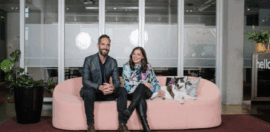Printing A Solution to the World’s Biggest Problems

3D Wash team members: Anirudra Das, Lachlan Patrick, Dr Mazher Mohammed, Dr Clara Usma Alvarez, Nathan Low and Tony Watson.
11 May 2017 at 8:52 am
“You are only limited by your imagination,” says Dr Mazher Mohammed, a research fellow at Deakin University’s School of Engineering, who is heading up a team working to use 3D printing to solve some of the developing world’s biggest problems.
The team is currently developing a world-first technology prototype capable of printing plumbing and sanitation supplies using discarded plastics, and thereby solving the dual problems of plastic rubbish and a lack of access to clean water supply.
The initiative, known as 3D Wash or Eco Printing, is set to be trialled in the Solomon Islands by children’s charity Plan International Australia later this year.
Mohammed says it is “kind of a utopian tool” that can solve many problems at once.
“This kind of 3D technology can be used to rapidly replace broken plastic seals, pipes and other devices essential for water supply or sanitation. This is critical as many disaster zones and developing areas do not have reliable access to power,” he says.
“The important part of this project is its sustainability. Not only will the printer be able to use plastic rubbish found nearby, but it will also run off a solar powered battery.”
Mohammed says the idea all started when he came across a “really sad” photo in a newspaper of water bottles floating in the ocean.
 “The scene was over in Indonesia in this tropical paradise, and it was just highlighting so many facets that were wrong with this in terms of the waste going from one country to another, tarnishing the landscape and basically being non biodegradable, so this stuff wasn’t going anywhere,” he says.
“The scene was over in Indonesia in this tropical paradise, and it was just highlighting so many facets that were wrong with this in terms of the waste going from one country to another, tarnishing the landscape and basically being non biodegradable, so this stuff wasn’t going anywhere,” he says.
“So I started wondering to myself, because the work that I’m involved with here involves 3D printing as a core technology, whether perhaps 3D printing could be used in some type of context to help with this issue.
“One of the main printing technologies that you would use, actually uses plastic as its main feedstock, as the core material that you make the products from in the printer, so I wondered to myself, could we take potentially recyclable plastics and convert that into a form that we could use in these 3D printers, and so that started the initial inception.”
Mohammed says he started offering it out as a student project and doing work on the side.
“Then I thought well could we go a stage further?” he says.
“If we can do this, can we take renewable energy to power everything and then move it into this whole concept of a minimised carbon footprint to convert what would be waste into usable items.
“So that kind of started the inception of what we called the Eco Printing project and we just did drips and drabs here and there to see where we could go.”
Mohammed jokes that the idea to take used plastics and convert them into materials that can be useful stems from him being from Yorkshire in the UK, where people are known to be “really tight”.
“This was me embracing my tight side,” he laughs.
“Anybody who his familiar with plastic printing will know this, that things can go wrong here and there. So once your print has failed it usually ends up in the bin… I said this was like gold, being thrown away into the bin,” he says.
“So we started playing around with a bit of the plastic which is prominently used in the printers called ABS plastic, and this is the stuff you would find say in the plastic in your cars on the inner panels or things like that or surrounding the electronic products, so we just roughly ground that down and used what they called a melt extrusion process which basically melts this plastic into a liquid form and then allows us to push this through a nozzle on the machine to form little cables or threads of this material and those threads are exactly what you could then put into the 3D printer to perform your printing.
“So the initial tests we did seemed to work quite nicely with this stuff so we were like: ‘Oh crap maybe we’re onto a winner with this one’.”
“It then led me to think, could we use other plastics… so we started investigating that and the most readily available source was milk cartons. We drink a lot of coffee in engineering, so the offices here are just ploughing through all of these milk cartons and they were ending up in the recycling bin. So I ended up in that embarrassing situation where people saw me rifling through the bins and washing out these cartons and then starting to try that out as well.
“And strangely enough that seemed to work… It made us think could we go even further and start taking waste that is out there in the environment and just use that.”
 Mohammed is joined on the team by Anirudra Das, Lachlan Patrick, Dr Clara Usma Alvarez, Nathan Low, Tony Watson, Sam Thomas, Ashiq Din Kodappully and Callum Vidler.
Mohammed is joined on the team by Anirudra Das, Lachlan Patrick, Dr Clara Usma Alvarez, Nathan Low, Tony Watson, Sam Thomas, Ashiq Din Kodappully and Callum Vidler.
He says the team have produced 3D printing filaments from different types of plastic rubbish, including milk bottles from the office kitchen, to print basic plumbing parts.
He says 3D printing is a “very versatile tool”.
“With 3D printing technology you are only really limited by your imagination on what you can create,” he says.
“The reason why it has become so popular is because if you can convert your design ideas into a three dimensional form digitally, using your basic design software on a computer, you can then realise that end product using your 3D printer. So you can do everything.
“We made usable mechanical parts, cogs, screws, all those things and we also make high end parts such as full blown skull models for biomedical application so it is a very, very versatile tool.”
Mohammed says 3D printing is already being used by aid agencies.
“We ended up in the conversation with Plan International mainly because they had been seeing from the likes of World Vision and Oxfam that 3D printing technology had been used to create high value parts in low volumes, [such as] basic medical devices or stuff for plumbing purposes to help people in impoverished and low socioeconomic environments,” he says.
“So we sat down with them and we were saying: ‘Oh yeah we’re pretty good at printing, even if we are blowing our own trumpet, and we can even go a stage further’.
“I told them about the pet project we had with using renewable technology and the recycling aspect and then the discussion led into the fact that plastics are actually a huge problem in these environments.
“It led us to think this could then be a double or even a triple win with the renewables. We could clear up the environment, we could solve this issue of all the waste being there which is otherwise damaging the environment, it’s not biodegradable, it’s blocking logistical infrastructure and then convert that into other things that could then supplement their basic requirements in an aid based context.”
 Plan Australia’s manager for water, sanitation and hygiene, Tom Rankin, says the potential applications of the technology – “powered by free and abundant sunshine” – are limitless.
Plan Australia’s manager for water, sanitation and hygiene, Tom Rankin, says the potential applications of the technology – “powered by free and abundant sunshine” – are limitless.
“This technology really lends itself to developing countries, where plastic waste has exceeded the capacity of governments to manage it,” Rankin says.
“In the streets of Honiara, there is plastic literally everywhere. It clogs up the drains and flows out into the sea, killing marine life. Our aim is to turn this plastic into useful parts.
“If we can prove the concept and get the technology working well, it can be used across a raft of different fields, not just water and sanitation. The potential for this is amazing.”
The printers will be trialled at Plan International Australia’s projects in the Solomon Islands later this year.
Meanwhile Deakin University is using crowdfunding to help meet the costs of the printers’ first prototypes.
More than $30,000 has been raised, exceeding the initial target, with support from the English Family Foundation.
Plan International Australia has also contributed $10,000 to the project, with additional financial support from Deakin’s Centre for Humanitarian Leadership and School of Engineering.
Mohammed says the project is “an ambitious one” but it is potentially a tool that can be taken anywhere in the world.
“To a certain degree, anybody can use this, we can see from the lessons learnt in the hobbyist community and the home consumer market, provided there is this little bit of CAD or computer aided design know-how, people can knock up basic designs,” he says.
“And even then people don’t necessarily need to have that know-how, on the internet there is all sorts of online resources and libraries of pre-existing designs made by the hobbyists and research communities which people have just full free access to download. A great example of this would be the fact that one of the most printed and downloaded parts is a yoda head.
“It is like you have this versatile tool and everyone wants to just print yoda off… But it just goes to show what is potentially out there.”
He says for the eco printing project they are planning to build all of the complexity into designs that they are then going to embed into the printer itself.
“So the printers come with memory sticks which can have essentially a design library on there of all the key parts that you may need. What we’re working on is to say come up with pipe connectors which are generic enough that they could work in any scenario on any size pipe for instance, and so the complexity of how that is has been managed by us over here, using our full design capacity and know how as an engineering department,” he says.
“The other aspect that we want to work on is that identification of what critical parts in the future we need to be working on as well, and integrate those into the library.
“Beyond that we want to develop a system which I call Deakin Remote, which would be using the internet to transmit designs to a particular target location on demand. So the joy of 3D printing again is that the interface is with a digital design which feasibly you could email from one person to another.
“So we could get a design brief so to speak from people in a remote area, when they do have that limited access that they have, they can tell us what that brief is and then when they get that access again we can transmit over the design using our product development capacity that we have here.
“We also want to develop that into a larger network globally where we can work with other academic institutes, other hobbyists communities, activists and the like to create a huge shared resource online where people can become part of this community, solve those same problems, but also provide these solutions that we can problem solve and basically validate using our facility here. So it is quite an ambitious one.”
Mohammed says his goal is to see the technology used in places where aid is required and where there are problems with sustainability, in terms of waste plastics in the environment.
“And we just develop these systems and give them over and then governmental aid agencies can provide that financial backing to make that a reality.
“So we enable these communities with their own tools to actually solve their own problems.
 “Beyond that the skills which are imparted into people from our system, give them a bit of insight into renewable technology. It allows them to expand their creativity in terms of the design aspects which interface with the 3D printer as well. They can also be their own material scientists by playing around with plastics.
“Beyond that the skills which are imparted into people from our system, give them a bit of insight into renewable technology. It allows them to expand their creativity in terms of the design aspects which interface with the 3D printer as well. They can also be their own material scientists by playing around with plastics.
“I see all those skills then being imparted onto those local communities and that empowers them to create their own solutions longer term, taking them out of this cycle of dependency.
You know that old adage: ‘Give a man a fish and it feeds him for a day, give a man a net and it feeds him [for his lifetime].’ We see this as the net technology rather than giving them a fish.”







